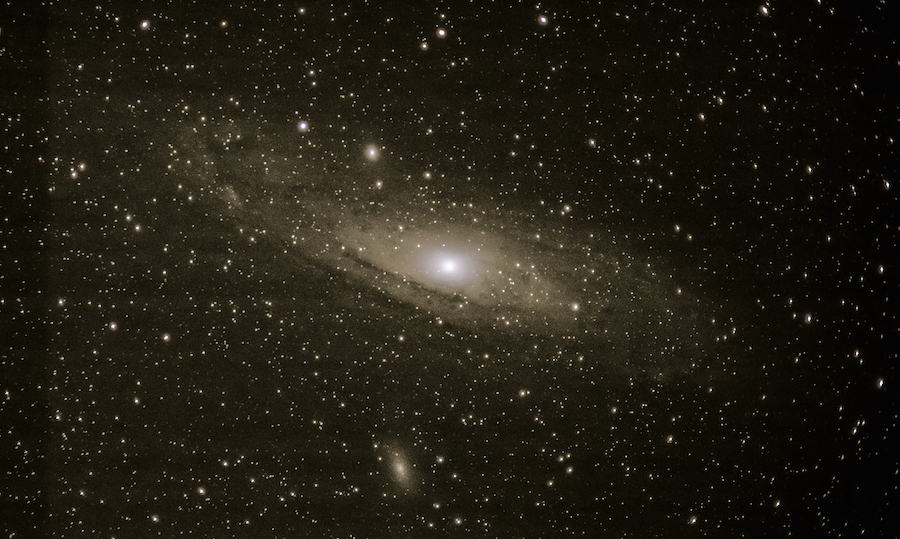
The possible emergence of new physics; cutting-edge measurements of the Hubble Constant
The night sky holds the secrets of the universe, and UC Davis professor Chris Fassnacht and an international team of collaborators are helping unlock its many mysteries.
Their research focuses on measuring the rate at which the universe is expanding. Fassnacht used an analogy to relate his group’s galactic research to California by comparing the measure of travel time from Los Angeles to Sacramento to how they measure the travel time of light from space to earth. Calculating the time it takes for cars to travel through California is like measuring the time it takes light from quasars, extremely bright celestial objects, to reach Earth. However, this specific technique of measuring the distance of light relies on how the the light of the quasars bends around a large galaxy. This galaxy acts as a gravitational lens and allows Fassnacht and his team of researchers to provide a new way of estimating the rate of expansion in the universe.
There are many intricate parts that go into creating the final estimation of the Hubble Constant, the rate at which the universe is expanding. Fassnacht was involved in several aspects of this project, which has been long in the making.
“I was the person who collected the data where we measured how fast the stars were moving in the lensing galaxy, and then I was also the [principal investigator] for most of the imaging,” Fassnacht said. “[It took] ten years of monitoring of looking at the system over and over again.”
According to Fassnacht, the process involves looking at the comparative brightness of the images containing the light from the quasar every couple of days and recording the brightness over time.
This group’s estimate for the Hubble Constant is creating an interesting contradiction in the world of astrophysics. An estimation made by the Planck Telescope measuring the cosmic microwave background is different from both H0liCOW’s — an international astrophysics collaboration — measurement and another more traditional method. All of these methods follow the same assumptions of the universe in order to create an approximate calculation of the Hubble Constant.
“If we continue to disagree, then it is a suggestion that there is something else going on,” Fassnacht said. “If we come up with a more complicated way of how the universe is put together it could bring our numbers into agreement and that is the hint of the new physics.”
However, Fassnacht is proceeding with caution due to large margins of error and other unforeseen complications.
“Here at UC Davis we are specializing in a particular branch of what we need for the project,” said Cristian Eduard Rusu, a postdoctoral fellow who worked under Fassnacht on this project. “Studying the environment of the lens, it’s not just a galaxy we are looking at but that galaxy is embedded in multiple galaxies. We need to account for the effect of those galaxies on the particular system that is of interest to us.”
To collect the data, the team used special telescopes to get images with a wide field of view, according to Rusu.
“Our approach is something new, we are basically taking older methods and updating them. We are bringing something theoretically new, for the first time putting in practice a more involved approach,” Rusu said. “We need a team [whose] job is to look for a decade at this particular lens, for us this was a team from Switzerland. We need people who actually take the Hubble Space images and look at that image and measure the lensing effect. All of this study goes together […] the final product is a statistical measurement of the Hubble Constant.”
Kenneth Wong, a UC Davis alumnus and East Asian Core Observatories Association (EACOA) postdoctoral fellow, is the researcher who analyzes the images from the Hubble Space telescope and works out of Japan.
According to Wong, who focuses mainly on lens modeling, locating the mass in the lensing galaxy, most of which is in dark matter, is an important aspect of measuring the Hubble Constant.
“The way we figure out where all of the mass is we have to look at how its bending the light from the background, and from that we fit a model to the galaxies,” Wong said.
Wong worked as an undergraduate with Fassnacht and joined this collaboration in late 2013. Fassnacht, Rusu and Wong are all part of the aforementioned international collaboration, H0liCOW, which Fassnacht helped found. These three researchers and their different specialties highlight the groundbreaking collaboration that this organization is promoting.
This research has created a new way to measure the galaxy through gravitational lensing. It is uniting the world of astrophysics — with UC Davis researchers and alumni leading the way.
Written by: Emma Askea — science@theaggie.org



